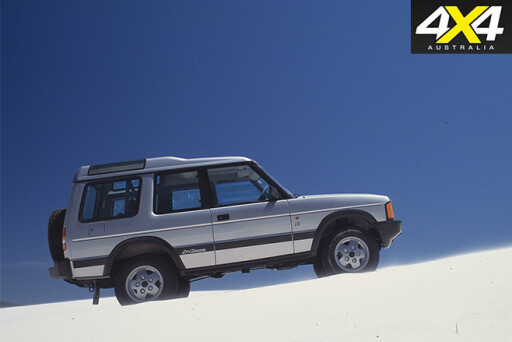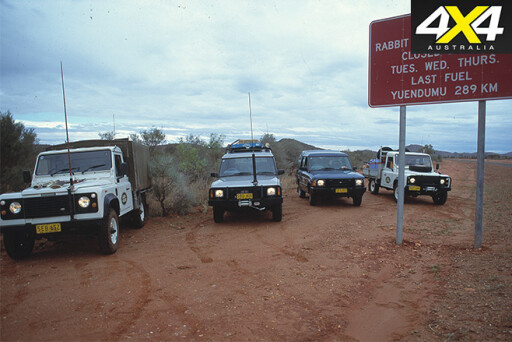
Time-travel back to late 1990, if you will. Here in Australia, Toyota’s brand new 80 Series Land Cruiser was selling like hotcakes, as was Nissan’s still relatively recent GQ Patrol.
Down the road at the Land Rover dealership, things weren’t so rosy. If you wanted a utilitarian workhorse 4x4, you could buy a 110 County wagon with either a 3.5-litre petrol V8 or a naturally aspirated 3.9-litre four-cylinder (Isuzu) diesel. Or you could go upmarket and buy a luxurious and expensive Range Rover. But if you wanted something in-between, in the form of an affordable family 4x4, then Land Rover had nothing for you.
Making matters worse for Land Rover dealers of the day was that both the 110 and the Range Rover were never going to be volume sellers. But things were to change, and change big time. In the UK in late 1989 Land Rover had rolled out the ‘all new’ Discovery, its first new model in 19 years. Demo models arrived in Australia in late 1990 for an on-sale date of March 1991.
 To say the Discovery was ‘all new’ is however a misnomer. Yes, the stepped roofline body and the airy, modern interior were new, but underneath the Discovery the mechanics were effectively the same as the Range Rover of the day, engine capacity and other details aside.
To say the Discovery was ‘all new’ is however a misnomer. Yes, the stepped roofline body and the airy, modern interior were new, but underneath the Discovery the mechanics were effectively the same as the Range Rover of the day, engine capacity and other details aside.
Initially available only as a modestly equipped three-door five-speed manual and only with a 3.5-litre petrol V8, the Discovery was nevertheless an instant success. The secret was the pricing. Here in Australia it was actually cheaper than a 110 County by a smidge ($41,995 versus $42,900) and under two-thirds the price of a Range Rover, which at that time with its 3.9-litre V8 started at $67,410.
Despite being a three-door, the Discovery still seated seven with roomy, inward-facing rear seats easily accessible via the rear door, while the broadness of the on- and off-road performance spectrum was every bit as good as you would expect from something that shared so much with the Range Rover.
 More variants soon followed. Late that year came the five-door V8 and the following year the five-door 2.5-litre (200 Tdi) diesel. An optional four-speed automatic for the V8 and a three-door diesel soon joined the range. In 1993 the 3.5 V8 was replaced by the 3.9 V8, the move accompanied by revised suspension now fitted with sway bars, which were considered by some to be a backwards step as they compromised the oh-so-supple ride, previously a Discovery highlight.
More variants soon followed. Late that year came the five-door V8 and the following year the five-door 2.5-litre (200 Tdi) diesel. An optional four-speed automatic for the V8 and a three-door diesel soon joined the range. In 1993 the 3.5 V8 was replaced by the 3.9 V8, the move accompanied by revised suspension now fitted with sway bars, which were considered by some to be a backwards step as they compromised the oh-so-supple ride, previously a Discovery highlight.
As the model range expanded, the ancillary equipment also became more sophisticated and extensive – a move often unfortunately matched by a deterioration in build quality.
In 1999 the Series 2 Discovery appeared. Although still essentially based on the same platform, the minimal styling changes hid far more significant mechanical and interior differences. In the cabin, the inward-facing third-row seats were replaced with conventional front-facing seats, while a new diesel engine, the five-cylinder Td5, was introduced.
 More noteworthy than these changes though was the introduction of electronic traction control (ETC), and so confident were Land Rover’s engineers of its ‘magical’ properties that the lock for the centre diff was deleted. In fact the lock remained in the transfer case, but the lever was deleted, a move that was subsequently reversed as the traction control always struggled to contain both the cross-axle and inter-axle wheelspin. And, in a sign of the new level of sophistication to come, active self-adjusting suspension (ACE, in Land Rover-speak) was also introduced.
More noteworthy than these changes though was the introduction of electronic traction control (ETC), and so confident were Land Rover’s engineers of its ‘magical’ properties that the lock for the centre diff was deleted. In fact the lock remained in the transfer case, but the lever was deleted, a move that was subsequently reversed as the traction control always struggled to contain both the cross-axle and inter-axle wheelspin. And, in a sign of the new level of sophistication to come, active self-adjusting suspension (ACE, in Land Rover-speak) was also introduced.
Despite its quality-control problems and the extensive evolution of what was a very old platform not really reaping commensurate reward, the original Discovery and the Series 2 remake established the Discovery name. And even better things were just around the corner.
Ford’s purchase of Land Rover from BMW in 2000 was behind the second milestone in the model’s evolution: the Discovery 3. Make no mistake, if it wasn’t for the massive injection of Ford cash, the Discovery 3 would never have happened. It first broke cover in 2004 and went on sale in Australia in early 2005.
 In designing and developing the Discovery 3, Land Rover’s engineers left no stone unturned and the D3 owed absolutely nothing to the original Discovery, or the Discovery 2. It was completely different, not only in the nuts and bolts, but in the whole design philosophy. It would prove to be a watershed vehicle, and not just for Land Rover.
In designing and developing the Discovery 3, Land Rover’s engineers left no stone unturned and the D3 owed absolutely nothing to the original Discovery, or the Discovery 2. It was completely different, not only in the nuts and bolts, but in the whole design philosophy. It would prove to be a watershed vehicle, and not just for Land Rover.
The D3 featured three key technologies that separated it from its predecessors. Most importantly, it swapped front and rear live axles for a fully independent suspension with optional height-adjustable air springs. It also introduced integrated and interconnected electronic control for the powertrain and the chassis, which allowed the driver to ‘tune’ the vehicle for different driving environments. This was Land Rover’s revolutionary ‘Terrain Response’ system.
The ultra-modern Jaguar-sourced 4.4-litre 32-valve quad-cam V8 was also a huge leap forward from the old pushrod V8s used previously, but the star of the new powertrain line-up was the 2.7-litre V6 turbodiesel coupled to a slick six-speed ZF automatic. This was Australia’s first taste of a modern, high-tech European turbodiesel in an affordable family 4x4. This was just the beginning.
 The Discovery 3 was clever, capable, practical, and a joy to drive both on and off the road, with truly astonishing breadth and depth of ability. In all regards, it was light years ahead of the old Discovery and set a benchmark in 4x4 design still relevant to this day.
The Discovery 3 was clever, capable, practical, and a joy to drive both on and off the road, with truly astonishing breadth and depth of ability. In all regards, it was light years ahead of the old Discovery and set a benchmark in 4x4 design still relevant to this day.
Proof of the Discovery 3’s brilliance came with the Discovery 4 that appeared in Australia late in 2009. Despite the five or so years that had passed since the D3 launch, Land Rover needed to do little to turn the D3 into the D4 and keep it thoroughly modern. In fact, aside from the introduction of a new 3.0-litre V6 bi-turbo diesel and 5.0-litre petrol V8, the changes were little more than skin deep.
However, one negative came with the bigger brakes fitted to the new 3.0-litre diesel and the associated compromise of low-profile tyres on the 19-inch wheels needed to clear the bigger brakes. That problem was further compounded when the 2.7-litre V6 diesel and the smaller brake package were dropped with the introduction of the new ‘low-power’ 3.0-litre V6 bi-turbo diesel and eight-speed ZF autos for the 2013 model year.
Despite its fair share of problems along the way, there’s no doubt the Discovery saved Land Rover from almost certain extinction. What started as little more than a new body on an old Range Rover platform has now become Land Rover’s defining model.

COMMENTS